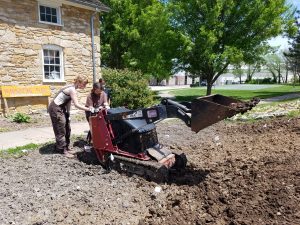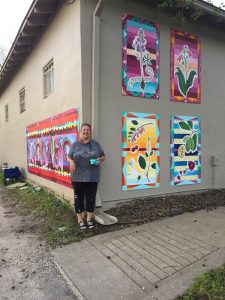My back is aching and in my 30 revolutions around the sun I have yet to accept that when I spend entire days working under its rays I will, inevitably, get an exhausting burn. My left wrist holds the memory of my less freckly winter skin. Trowels, shovels, dense clayey soils, cold beers, pillbugs, ants, and limestone rocks are my closest confidants. My heart is full and my smile lines grow deeper by the hour.
Last Spring, over coffee with a dear friend and mentor, I curmudgeonly lamented over our technological age and how we are increasingly losing connection with our natural surroundings. I digressed into a rant and the weight from their long slow eye roll snapped me out of my tangent.
I know. I was not made for these times.
Nonetheless, as any good mentor would, they nodded, smiled, and countered my lament with a challenge: You live in this world, so what are you going to do?
So, I set out to create a learning garden that emphasizes native and wild plants in the hope to create a space where people interact with nature while learning about the benefits these plants have for pollinators, soils, water, and our overall well-being. A year after applying for a grant to make this vision a reality, I am preparing a plot of land in Hobbs Park to house the garden.
When it rains, my body welcomes a rest day and I open my copy of Braiding Sweetgrass by Robin Wall Kimmerer, gifted to me by my Aunt Marie and Uncle Jack. Their handwriting on the first page hopes that the grace of reciprocity will be in my nature and reminds me to always be surprised by the gift of gratitude.
The neighbors donate thousands of pounds of limestone to the garden and, with the help of friends, I spend my evenings and weekends loading these rocks into my car and unloading them at the garden. I forget to use my legs to lift more often than I remember. I pause my work to walk down the street to watch my friend Mona paint a mural on the side of Dragon’s Hoard. She pauses from her work and brings her children to the garden where they quickly become experts at navigating the garden machinery. I miscalculate space and I always underestimate the time it will take to accomplish anything. I misplace my work gloves and smash my fingers between behemoths of stone. I admire as my partner patiently helps me with these tedious tasks. My heart is full and my smile lines grow deeper by the hour.
The plants that will grow in this garden were selected through a combination of oral history interviews, archival research and advice from local plant experts. Neighbors whose families have lived in East Lawrence for generations shared their plant memories and neighborhood children shared drawings and poems of their favorite plants.
These plants exhibit the inner-workings of a healthy and thriving ecosystem. Plants that have long been tended to by the humans who have co-inhabited this land with them. Plants that attract and support vital pollinators. Plants that reduce erosion. Plants that delight the senses and can be used as remedies for sleepless nights and mosquito bites. Plants that exemplify collaboration and encourage hope.
Kimmerer writes of how the smell of sweetgrass reminds us of forgotten memories. In these days of isolation, I find myself feeling extremely grateful that I get to work with living things that inherently do so much good. As I dig, I inhale the comforting scent of wet soil and try to recall future memories of the vibrant contrast of coneflowers aside Black-eyed Susans and spiderwort, the fast swoosh of a hummingbird flying towards food, and the aroma of lavender and sage. I've learned that this is what reciprocity and gratitude smell like. My heart is full and my smile lines grow deeper by the hour.
-Kaitlin Stanley is a Readers' Services Assistant at Lawrence Public Library.





Add a comment to: Learning Gardens